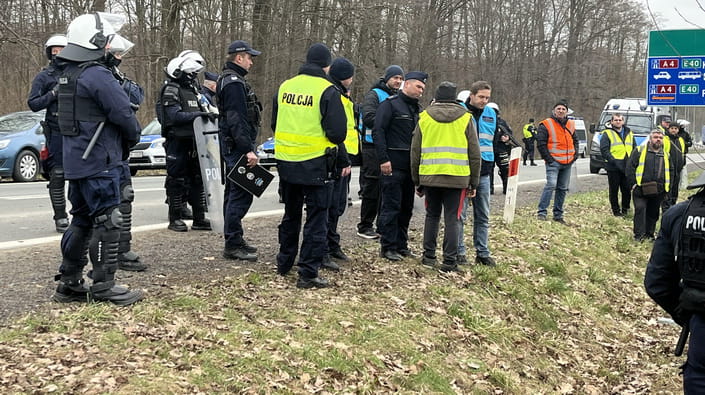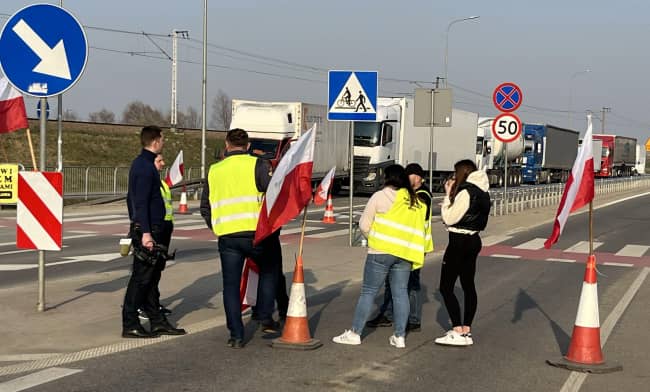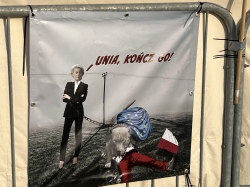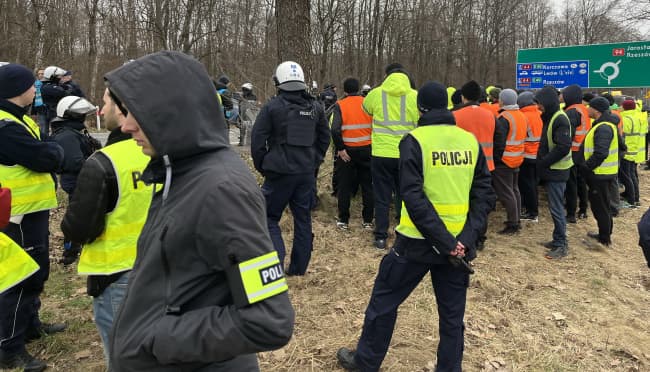Report from the border: how Polish authorities and protesters are blocking trade with Ukraine

On 1 March, Polish hauliers renewed their border blockade, dramatically worsening the already difficult situation with the passage of goods.
And most importantly, it confirmed the failure of the attempt by Donald Tusk's government to unblock the border by reaching a compromise with the protesters.
The outcome of the Polish government's attempts to manage the border crisis had been obvious. Once the hauliers had temporarily left the border, it was almost immediately blocked by Polish farmers.
As European Pravda predicted, the blockade of the Polish-Ukrainian border has become a convenient lever with which to put pressure on the government, even on issues that have nothing to do with Ukraine.
And the Polish government had virtually admitted defeat even before the strengthening of the blockade in March.
It’s no coincidence that Donald Tusk has been talking – whether seriously or half-jokingly – about possibly closing the border with Ukraine altogether.
So what’s happening now at the blocked border? What has changed since the hauliers’ blockade resumed?
European Pravda went to the border from the Polish side to see for ourselves how some small groups of protesters are holding the economies of both Ukraine and Poland hostage.
The blockade is "not because of Ukraine"
29 February, the last day of winter, was also the last day of the blockade by Polish farmers alone. Their actions have often caused outrage in Ukraine in recent weeks.
The name of the Polish village of Medyka, located right on the border with Ukraine, has been cropping up particularly frequently in the news. That’s because there are two border crossings nearby – one for pedestrians and vehicles, and one rail border (the train to Przemyśl, popular with Ukrainians, crosses the border there).
Medyka is also where the most intense events of recent weeks have taken place – attacks on Ukrainian freight, symbolic acts of spilling grain, and even attacks on trains.
But the Polish police did their "cleanup work", and now there is little left to remind us of those turbulent events.
To a random traveller who finds themselves near Medyka, it might even seem that the border blockade situation has been resolved. On his way from Przemyśl, European Pravda’s correspondent saw only one queue of twenty lorries with Ukrainian plates, guarded by police cars on both sides.
The same goes for the border itself. The picket is not right in front of the checkpoint, by the way, as it may appear in the news – it’s a couple of kilometres away from the border. On 29 February, there were a dozen or so protesters camping and resting there.

There are far more police officers than protesters, plus huge numbers of Polish flags and posters. It was noticeable that the police were trying to protect the Ukrainian hauliers’ freight. This has stopped the attacks on Ukrainian freight at the border, although they have started happening inside the country.
Another strange thing is the absence of any queue at the closed border.
There are a dozen lorries that have arrived from Ukraine next to the Polish farmers’ "checkpoint", and no queue to exit Poland.
The protesters are happy to talk to camera for a film crew from Polish TV channel TVP, but they refuse to speak – even in Polish – with European Pravda’s correspondent, claiming that their spokesperson is now in Warsaw, where massive protests are also taking place.
Only one of them couldn't hold back, emphasising that none of their posters contain any complaints about Ukrainians: "We’re protesting against the EU, not Ukraine." I answer that all the same, Ukrainians are suffering as a result of their blockade. The farmer shrugs. "If you were in the EU, your farmers would be protesting just like this."
This is true. All the protesters' posters are critical of the EU’s Green Deal, which Polish farmers are demanding should be reviewed. The only slogan that could possibly be described as "anti-Ukrainian" is a call to ban honey imports.

But this pretty picture is shattered when you talk to the Ukrainian lorry drivers.
They say that after crossing the Polish border, they have to wait three more days to get through the protesters' checkpoint – in addition to almost a month of waiting in Ukraine, although that’s in an electronic rather than a regular queue.
The reason for the long wait at the checkpoint is because both entry and exit protesters have been letting only one vehicle through per hour.
And the reason why there is no lorry queue is that the vehicles, along with the police, are waiting at lorry parks further away from the border.
This is a lot more convenient for the Polish police, because it prevents large-scale protests by outraged Ukrainian drivers and creates a positive image, as if everything at the border is calm. However, this image becomes impossible to maintain when the blockade ramps up.
Worse than the farmers
The first of March was always going to be difficult. That was the day on which the Polish hauliers had vowed they would renew their blockade. Traffic was a bit slow on the last day of winter, but it was still getting through; on the first day of spring, the passage of lorries through Medyka was completely blocked. The situation was even more problematic at the Korczowa checkpoint a few dozen kilometres away.
Korczowa is a larger border crossing point and more significant for lorry traffic. And the scale of the problems there is even more obvious, simply because some of the lorry parks here are located near the border. There are hundreds of Ukrainian lorries waiting there.
According to Ukrainian drivers, there are currently about two thousand vehicles queueing at Korczowa (the Ukrainian Ministry of Infrastructure says there are about 700 lorries).
The protesters’ slogans have also changed as the blockade has intensified. While the farmers now emphasise that they are protesting against the EU and the border is just a convenient location to get their voices heard by the government,
the Polish hauliers make no secret of the fact that their blockade is directed against Ukraine.
Their posters have slogans like "Ukrainians are taking away my job".
The protesting hauliers are noticeably more aggressive than the farmers. They not only refused to talk but also tried to prevent European Pravda from taking photos. A police officer had to intervene and explain to the lorry drivers that journalists do not need permission from the local authority, the voivodeship, to take photographs.
The police are obviously prepared for an escalation, including possible physical clashes.
Our correspondent saw them preventing an altercation a few kilometres away from the border, where the Polish police (including a group of special forces with helmets and shields) blocked several groups of Ukrainian drivers.

Ukrainian drivers blocked by the police
According to the Ukrainians, the conflict broke out in the morning when the police announced that the protesters had changed the rate at which Ukrainian lorries could pass. The day before, up to 26 vehicles per hour had been able to pass through the checkpoint. But from 1 March, the protesters agreed to let only one lorry pass per hour. Considering the amount of traffic that flows through this checkpoint, this is virtually nothing. And when some Ukrainian drivers gathered together and set off to see the protesters – seeking, they say, to negotiate with them – the police surrounded them. It was several hours before they allowed the drivers to return to their vehicles.
"The police protect their protesters and don’t let us even talk to them, whereas we have no rights. They can pretty much hold us hostage, depriving us of the right to move," Ukrainian drivers told European Pravda.
Who benefits?
Our two days at the Ukrainian-Polish border have given us enough evidence to draw several conclusions.
Firstly, the blockade in its current form would have been impossible without the active involvement of the Polish police and border guards.
Officially, their objective is to prevent clashes at the border. But in reality, the police are siding with the protesters. They are essentially coordinated with them. In fact, it’s representatives of the Polish authorities who allow vehicles to reach the border or determine the rate of border crossings, implementing the "quotas" agreed upon by the protesters.

Secondly, the Polish protesters’ actions often provoke Ukrainians into conflict – such as their regular revision of the "quota" for the number of vehicles they are willing to allow across the border. Even their stated norms, even the minimum of "one vehicle per hour", are often violated, particularly during the night, when protesters often refuse to let vehicles through at all.
And that isn’t a problem for the Polish authorities, including the police. The containment measures are aimed squarely against Ukrainians.
The Ukrainian drivers also believe that the blockade does not apply to everyone.
They allege that the Polish police sometimes escort lorries to the border even when it is completely blocked. This is a mechanism for letting military supplies or humanitarian aid through, but the drivers in the queue are convinced that it's not just that.
"They create a good image for the sake of reporting: the border operates around the clock, but the queue doesn't move at night. Instead, they let anyone who has made agreements with the Poles through," the Ukrainian drivers argue.
They also note that in the queue at the border, "there are vehicles that are officially registered here, but in fact, they are already in Ukraine loading up for the next trip".
It's unlikely that this information can be independently verified, but the drivers at least are convinced that the border blockade is creating opportunities for some. And this further disincentivises any attempts to overcome it, despite the multi-million-dollar losses that are hurting both the Ukrainian and Polish economies.
Three major associations of Polish and Ukrainian businesses have appealed to the Polish government, asking it to resolve the border blockade situation as speedily as possible and prevent it from deteriorating further.
Yet the Polish authorities continue to studiously ignore this issue. As President Andrzej Duda has stated, the Polish government cannot restrict the right of either the farmers or the hauliers to organise lawful protests, and they have grounds to do so.
Yurii Panchenko, European Pravda
reporting from Medyka and Korczowa, Poland
